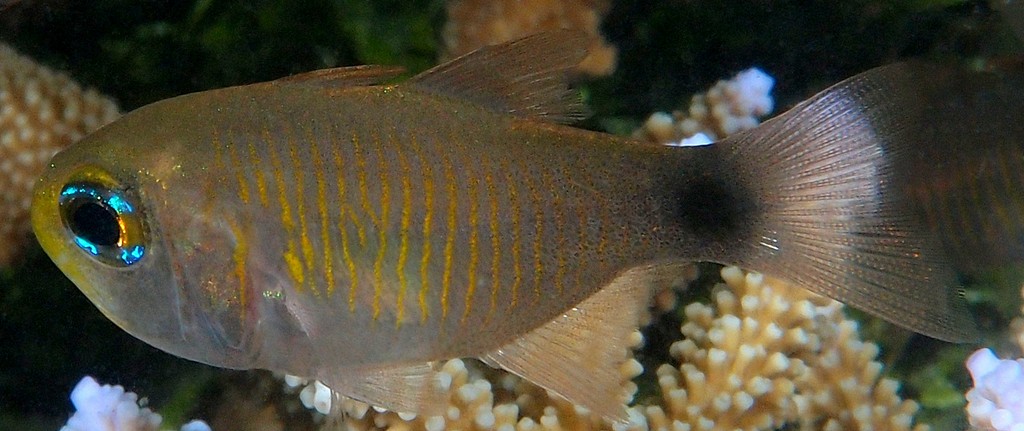TAENIAMIA MACROPTERA - (CUVIER, 1828)
Actinopterygii (Gigaclass) > Actinopteri (Class) > Teleostei (Subclass) > Gobiiformes (Order) > Apogonoidei (Suborder) > Apogonidae (Family) > Apogoninae (Subfamily) > Taeniamia (Genus)
Dusky-tailed cardinalfish, Faint-lined cardinalfish, 原長鰭天竺鯛,
Synonymes
Apogon argenteus (Valenciennes, 1832)
Apogon macropterus (Cuvier, 1828)
Apogon macropteus (Cuvier, 1828)
Apogon zeylonicus (Cuvier, 1829)
Archamia macroptera (Cuvier, 1828)
------------------------
Description
Dorsal spines (total): 7; Dorsal soft rays (total): 9; Anal spines: 2; Anal soft rays: 13-15; Pectoral fin rays: 13-15 (usually: 14); Gill rakers: 5-6 + 15-17; Lateral line scales: 25 + 3-5. Median predorsal scales: 5-7. Body depth: 2.4-2.7 in SL; Body width: 2.3-2.6 in body depth; Eye diameter: 2.55-3.0 in head length; First dorsal spine: 2.0-2.9 in second spine; Second dorsal spine: 2.3-2.9, and third dorsal spine 2.4-2.8 in head length; Spine of second dorsal fin: 2.3-2.8, and second anal spine: 2.6-3.2 in head length; Pelvic fin length: 4.5-5.15 and caudal-peduncle length: 4.3-5.4 in SL; Distance from insertion of pelvic spine to anal-fin origin: 3.8-4.8 in SL. Basilingual teeth absent. Posterior preopercular edge completely serrate, or nearly so; Ventral edge serrate on posterior half. Scaly sheath along anal-fin base poorly developed or absent. Max. length: 9.5 cm TL. Depth range: 2 - 20 m.
Color
Caudal peduncle being largely dusky to black and without stripe across snout.
Etymology
Taeniamia: from Latin, taenia = ribbon, band + from Greek, amia, -as = a kind of bonito. Name given by Aristotle to a fish (later name applied to Apogon by Gronow (1763), now a commonly used suffix in the family). Referring to the vertical wide bars and near vertical to curved narrow bars as lines on most of the species in this genus.
macroptera: from Latin, macro- = long, big, wide + from Greek, pteron = wing, fin. Referring to longer anal fin compared to most congeners then placed in Apogon.
Original description: Apogon macropterus Cuvier, 1828 - Type locality: Java, Indonesia.
Distribution
Indo-West Pacific: eastern India and Sri Lanka east to Samoa, north to Yaeyama Islands, south to New Caledonia.
Biology
Occurs in estuaries and sheltered bays, often silted habitats. Congreates in large schools, usually floating just above large branching coral beds. Mouthbrooders. Distinct pairing during courtship and spawning.
Similar species
Last update: 9, August 2022
Dusky-tailed cardinalfish, Faint-lined cardinalfish, 原長鰭天竺鯛,
Synonymes
Apogon argenteus (Valenciennes, 1832)
Apogon macropterus (Cuvier, 1828)
Apogon macropteus (Cuvier, 1828)
Apogon zeylonicus (Cuvier, 1829)
Archamia macroptera (Cuvier, 1828)
------------------------
Description
Dorsal spines (total): 7; Dorsal soft rays (total): 9; Anal spines: 2; Anal soft rays: 13-15; Pectoral fin rays: 13-15 (usually: 14); Gill rakers: 5-6 + 15-17; Lateral line scales: 25 + 3-5. Median predorsal scales: 5-7. Body depth: 2.4-2.7 in SL; Body width: 2.3-2.6 in body depth; Eye diameter: 2.55-3.0 in head length; First dorsal spine: 2.0-2.9 in second spine; Second dorsal spine: 2.3-2.9, and third dorsal spine 2.4-2.8 in head length; Spine of second dorsal fin: 2.3-2.8, and second anal spine: 2.6-3.2 in head length; Pelvic fin length: 4.5-5.15 and caudal-peduncle length: 4.3-5.4 in SL; Distance from insertion of pelvic spine to anal-fin origin: 3.8-4.8 in SL. Basilingual teeth absent. Posterior preopercular edge completely serrate, or nearly so; Ventral edge serrate on posterior half. Scaly sheath along anal-fin base poorly developed or absent. Max. length: 9.5 cm TL. Depth range: 2 - 20 m.
Color
Caudal peduncle being largely dusky to black and without stripe across snout.
Etymology
Taeniamia: from Latin, taenia = ribbon, band + from Greek, amia, -as = a kind of bonito. Name given by Aristotle to a fish (later name applied to Apogon by Gronow (1763), now a commonly used suffix in the family). Referring to the vertical wide bars and near vertical to curved narrow bars as lines on most of the species in this genus.
macroptera: from Latin, macro- = long, big, wide + from Greek, pteron = wing, fin. Referring to longer anal fin compared to most congeners then placed in Apogon.
Original description: Apogon macropterus Cuvier, 1828 - Type locality: Java, Indonesia.
Distribution
Indo-West Pacific: eastern India and Sri Lanka east to Samoa, north to Yaeyama Islands, south to New Caledonia.
Biology
Occurs in estuaries and sheltered bays, often silted habitats. Congreates in large schools, usually floating just above large branching coral beds. Mouthbrooders. Distinct pairing during courtship and spawning.
Similar species
- Taeniamia biguttata (Lachner, 1951) - Reported from Western Pacific: Indonesia east to Philippines and Samoa, north to Taiwan, south to Papua New Guinea. Deep bodied with a large "ear" spot and numerous thin orange, near vertical lines. With or wihtout a pupil-sized black spot centrally on caudal fin base. A black band slightly angled backward from below eye. A short yellow line across snout.
- Taeniamia fucata (Cantor, 1849) - Reported from New Caledonia - Link to the species (here). Numerous yellow to orange thin lines along entire sides, vertical on upper and angling forward on lower half. A yellow stripe across snout. An up to eye-size black blotch on caudal fin base variable from small to large occasionally absent.
- Taeniamia kagoshimana (Döderlein, 1883) - Reported from Northwestern Pacific: Japan. Brownish blotch at eye level over the first few vertical lines closely above and behind pectoral fin base.
- Taeniamia lineolata (Cuvier, 1828) - Reported from Red Sea, northwestern Indian Ocean: Gulf of Aden. Yellow on head and over abdomen, greyish dorsally and many reddish, thin vertical lines. Pale semitransparent whitish grey at night, bluish dorsally with many vertical lines formed by close-set minute black or red spots. A large, up to eye-size basicaudal spot.
- Taeniamia sansibarica (Pfeffer, 1893) - Reported from Western Indian Ocean: Zanzibar (Tanzania); Seychelles; Maldives. Similar to Taeniamia fucata, but somewhat transparent pale yellowish grey with numerous indistinct thin yello lines. Spot on centre of caudal fin base small or absent. Snout with yellow line across.
Last update: 9, August 2022
